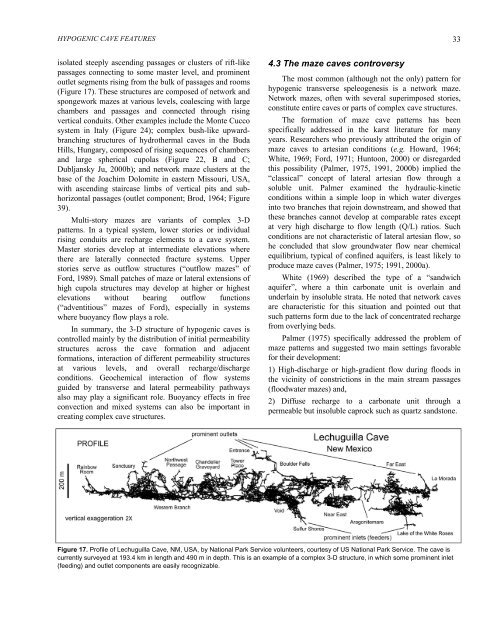Download PDF - Speleogenesis
Download PDF - Speleogenesis
Download PDF - Speleogenesis
You also want an ePaper? Increase the reach of your titles
YUMPU automatically turns print PDFs into web optimized ePapers that Google loves.
HYPOGENIC CAVE FEATURES<br />
isolated steeply ascending passages or clusters of rift-like<br />
passages connecting to some master level, and prominent<br />
outlet segments rising from the bulk of passages and rooms<br />
(Figure 17). These structures are composed of network and<br />
spongework mazes at various levels, coalescing with large<br />
chambers and passages and connected through rising<br />
vertical conduits. Other examples include the Monte Cucco<br />
system in Italy (Figure 24); complex bush-like upwardbranching<br />
structures of hydrothermal caves in the Buda<br />
Hills, Hungary, composed of rising sequences of chambers<br />
and large spherical cupolas (Figure 22, B and C;<br />
Dubljansky Ju, 2000b); and network maze clusters at the<br />
base of the Joachim Dolomite in eastern Missouri, USA,<br />
with ascending staircase limbs of vertical pits and subhorizontal<br />
passages (outlet component; Brod, 1964; Figure<br />
39).<br />
Multi-story mazes are variants of complex 3-D<br />
patterns. In a typical system, lower stories or individual<br />
rising conduits are recharge elements to a cave system.<br />
Master stories develop at intermediate elevations where<br />
there are laterally connected fracture systems. Upper<br />
stories serve as outflow structures (“outflow mazes” of<br />
Ford, 1989). Small patches of maze or lateral extensions of<br />
high cupola structures may develop at higher or highest<br />
elevations without bearing outflow functions<br />
(“adventitious” mazes of Ford), especially in systems<br />
where buoyancy flow plays a role.<br />
In summary, the 3-D structure of hypogenic caves is<br />
controlled mainly by the distribution of initial permeability<br />
structures across the cave formation and adjacent<br />
formations, interaction of different permeability structures<br />
at various levels, and overall recharge/discharge<br />
conditions. Geochemical interaction of flow systems<br />
guided by transverse and lateral permeability pathways<br />
also may play a significant role. Buoyancy effects in free<br />
convection and mixed systems can also be important in<br />
creating complex cave structures.<br />
4.3 The maze caves controversy<br />
The most common (although not the only) pattern for<br />
hypogenic transverse speleogenesis is a network maze.<br />
Network mazes, often with several superimposed stories,<br />
constitute entire caves or parts of complex cave structures.<br />
The formation of maze cave patterns has been<br />
specifically addressed in the karst literature for many<br />
years. Researchers who previously attributed the origin of<br />
maze caves to artesian conditions (e.g. Howard, 1964;<br />
White, 1969; Ford, 1971; Huntoon, 2000) or disregarded<br />
this possibility (Palmer, 1975, 1991, 2000b) implied the<br />
“classical” concept of lateral artesian flow through a<br />
soluble unit. Palmer examined the hydraulic-kinetic<br />
conditions within a simple loop in which water diverges<br />
into two branches that rejoin downstream, and showed that<br />
these branches cannot develop at comparable rates except<br />
at very high discharge to flow length (Q/L) ratios. Such<br />
conditions are not characteristic of lateral artesian flow, so<br />
he concluded that slow groundwater flow near chemical<br />
equilibrium, typical of confined aquifers, is least likely to<br />
produce maze caves (Palmer, 1975; 1991, 2000a).<br />
White (1969) described the type of a “sandwich<br />
aquifer”, where a thin carbonate unit is overlain and<br />
underlain by insoluble strata. He noted that network caves<br />
are characteristic for this situation and pointed out that<br />
such patterns form due to the lack of concentrated recharge<br />
from overlying beds.<br />
Palmer (1975) specifically addressed the problem of<br />
maze patterns and suggested two main settings favorable<br />
for their development:<br />
1) High-discharge or high-gradient flow during floods in<br />
the vicinity of constrictions in the main stream passages<br />
(floodwater mazes) and,<br />
2) Diffuse recharge to a carbonate unit through a<br />
permeable but insoluble caprock such as quartz sandstone.<br />
Figure 17. Profile of Lechuguilla Cave, NM, USA, by National Park Service volunteers, courtesy of US National Park Service. The cave is<br />
currently surveyed at 193.4 km in length and 490 m in depth. This is an example of a complex 3-D structure, in which some prominent inlet<br />
(feeding) and outlet components are easily recognizable.<br />
33
















